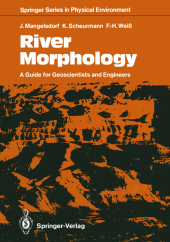 Neuerscheinungen 2011Stand: 2020-01-07 |
Schnellsuche
ISBN/Stichwort/Autor
|
Herderstraße 10
10625 Berlin
Tel.: 030 315 714 16
Fax 030 315 714 14
info@buchspektrum.de |

Joachim Mangelsdorf, Barbara Reimer, Karl Scheurmann, Fritz-Heinz Weiß
(Beteiligte)
River Morphology
A Guide for Geoscientists and Engineers
Übersetzung: Reimer, Barbara
2011. xiii, 243 S. 4 SW-Abb. 242 mm
Verlag/Jahr: SPRINGER, BERLIN 2011
ISBN: 3-642-83779-4 (3642837794)
Neue ISBN: 978-3-642-83779-1 (9783642837791)
Preis und Lieferzeit: Bitte klicken
River Morphology deals with the interaction between flowing waters in rivers and their environment. Based on the representation of basic flow parameters, the geometry, classification and historic development of rivers are treated. Any change in the environment, occurring naturally or caused by man, leads to very sensitive reactions in river flow and transport. Thus this synopsis of geoscientific studies and hydraulic engineering experience is presented to help develop the unterstanding of how to handle nature with care.
1 Introduction.- 2 Historic Overview.- 3 Hydraulics of Stream Flow.- 3.1 Basic Laws of Channel Hydraulics.- 3.1.1 Steady Uniform Flow.- 3.1.2 Distribution of Velocities.- 3.1.3Flow in Meandering Channels.- 3.2 Influence of the Earth´s Rotation.- 3.2.1 Baer´s Law.- 3.2.2 Coriolis Force.- 3.2.3 Centrifugal Force.- 3.2.4 Influence on Tidal Rivers.- 3.3 Density Currents.- 4 Sediments.- 4.1 Differentiation Between Bedload and Suspended Load.- 4.2 Bedload.- 4.2.1 Measurement of Bedload.- 4.2.1.1 Direct Bedload Measuring.- 4.2.1.2 Indirect Bedload Measuring.- 4.2.2 Sampling and Grain Size Analyses.- 4.2.3 Derivation and Composition.- 4.2.4 Attrition of Bedload Components.- 4.2.5 Critical Shear Stress and Velocity.- 4.2.6 Mechanics of Transport.- 4.2.7 Computation of Bedload Transport and Yield.- 4.3 Suspended Load.- 4.3.1 Measurement of Suspended Load.- 4.3.1.1 Individual Point Measurements.- 4.3.1.2 Multi-Point Measurements (Full-Range Measurements).- 4.3.1.3 Depth-Integrating Samplers.- 4.3.1.4 Continuous Measurements.- 4.3.2 Grain Size Analyses.- 4.3.3 Derivation and Composition.- 4.3.4 Distribution of Suspended Matter.- 5 Channel Geometry.- 5.1 Network Evolution as an Interconnected System.- 5.2 River Channel Patterns.- 5.2.1 Descriptive Parameters of Channel Development.- 5.2.2 Straight River Channels.- 5.2.3 Braided River Channels.- 5.2.4 Meandering River Channels.- 5.2.4.1 Meandering Valleys, Incised Meanders.- 5.2.4.2 River Meanders.- 5.3 Longitudinal Section.- 5.3.1 Channel Gradient.- 5.3.2 Equilibrium Gradient.- 5.3.3 Self-Stabilization of Eroding Rivers.- 5.4 Cross-Section.- 5.4.1 Shapes of Valleys.- 5.4.2 Cross-Section of Rivers.- 5.5 Fargue´s Laws.- 5.6 Regime Theory.- 6 Classification of Rivers.- 6.1 Drainage Basins, Divides, and Their Structural Controls.- 6.2 Drainage Density, Channel Frequency.- 6.3 Drainage Systems, Types of Rivers.- 6.3.1 Drainage Patterns.- 6.3.2 Topographic-Morphologic Types.- 6.3.2.1 Torrents, Mountain Creeks, and Mountain Rivers.- 6.3.2.2 Rivers of High Plateaus and Tablelands.- 6.3.2.3 Rivers in Low Mountains and Hilly Country.- 6.3.2.4 Rivers of Plains, Mixed Types.- 6.3.2.5 River Mouths.- 6.3.3 Climate-Controlled Types of Rivers.- 6.3.4 Discharge Regimes.- 6.3.4.1 Definition.- 6.3.4.2 Discharge Regimes after Parde.- 7 River History.- 7.1 River History as Part of Geological History.- 7.1.1 River and Climate - Exodynamics.- 7.1.1.1 Formation of Terraces.- 7.1.1.2 Change of Land Forms in Coastal Areas.- 7.1.2 River and Tectonics - Endodynamics.- 7.1.2.1 Formation of Terraces.- 7.1.2.2 Transverse Valleys, Antecedence, Epigenesis, River Capture.- 7.2 River History as Part of the History of Civilization.- 8 Investigations in River Morphology.- 8.1 Methods.- 8.1.1 Hydrographs of Annual Mean Water Level at the Gages.- 8.1.2 Cross Section Surveys.- 8.1.3 Recording of Mean Low Water Level.- 8.1.4 Methods of Calculation.- 8.1.5 Aerial Photogrammetry.- 8.2 Examples for Degradation of River Beds Below Barrages and Weirs.- 8.3 Possibilities for Rehabilitation of Degradation Stretches.- 8.3.1 Derivation of Technological Approaches from the "Swiss Formula".- 8.3.2 Rehabilitation by Increasing Drag.- 8.3.2.1 Stabilization by Armoring.- 8.3.2.2 Bottom Belts and Sills.- 8.3.2.3 Addition of Bed Material.- 8.3.3 Rehabilitation by Reduction of Flow Velocity or Gradient.- 8.3.3.1 Widening of the Channel.- 8.3.3.2 Drops and Weirs with Low Heads.- 8.3.3.3 Stone Ramps.- 8.3.3.4 Sustaining Barrages and Power Plants.- 8.3.3.5 Low-Head Hydro-Power Plants.- 8.3.4 Conclusions.- References.- Authors Index.


